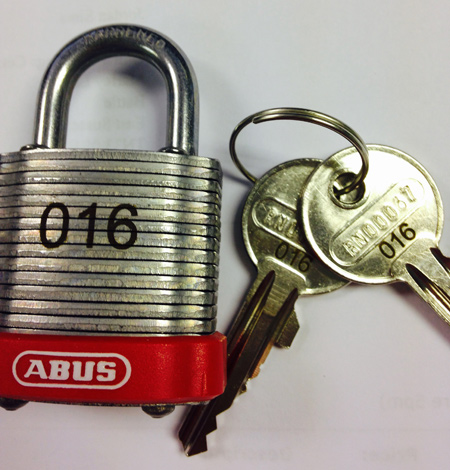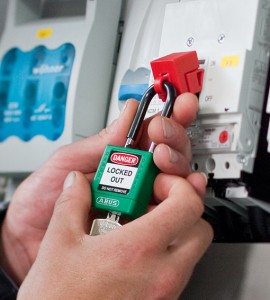Padlocks used for locking electrical switches to prevent machinery, or other items being either used or switched off, are known as lock-off, lock-out or tag-out. There are a number of considerations to take into account before you decide which lock to go for. We’ve made this page in order to cut straight to the chase:
1. Colour coding / sequential engraving
If you want different switches or access doors to use different sets of locks, then having them marked or colour coded is important. There are only a few locks that are colour coded and we list those in our Safety Padlocks Section. Some are entirely one colour whilst others have plastic markers or bands.
On the right is an example of a lock we do for the UK National Grid. It is both laser engraved and has a red marker. Other sets they have include Green and Blue. The keys are also marked sequentially.
2. Custom built
As with the example above, if you have colour coding then you may want different sets to interact with each other. In the National Grid case above they have a large lock for access to substations marked green, a medium sized lock for internal electrical cabinets marked blue and then lock-off ‘switch locks’ marked red. The red keys open all the locks, the Blue keys open both blue and green and green only opens itself.
This type of setup can only come from locks which are serviceable and made up to order. If you’re ordering off the shelf locks, which are often made in China, then this will not be an option. You should also choose a brand of lock that has a facility in Europe so that you can get more quickly and not have to wait months. In our Safety Padlocks Section the ABUS 74’s and the Eterna locks can be made up to order in Germany. The others are off the shelf. Ensure you check this out before ordering your locks from a supplier.
3. No. of keys
A lot of orders we have done specifically ask for their locks to only have a single key per lock. With only one key there is minimal chance of a key getting lost and being used accidentally. Many locks you buy, even the colour coded ones, come with 2 or 3 keys so it would be a real pain in the arse to receive 1000 locks and have to work through them to discard the others. Likewise if you wanted 2 keys per lock, receiving only 1 would be frustrating. In our Safety Padlocks Section only the specialised lockout padlocks have 1 key each whilst the others have 2.
4. Differ number
Now this one is important. Often your health and safety protocols will state that the chance of key duplication either needs to be minimised or even guaranteed. Most 30mm and 40mm padlocks will only have around 250-500 key differs which means after that number they will repeat. In most circumstances that is not a big problem but where it is securing machinery that could mean life or death for someone, then more differs are required; maybe 1000+. For this you need specific locks that contain more pins and therefore more key variations, such as the ABUS 74 series.
That said, even if you have a padlock which has 1000 different key variations there is no guarantee that they will all be different within a certain batch. For that you need to have them made by hand and recorded. We call this “Guaranteed Differ” padlocks. It is an expensive option but can be done. They are usually also engraved and recorded so we know every individual key cut within the group, which allows us to add more in the future.
5. Anti Spark / Non-conductive / Insulated
For electrical applications it is often desirable to have a lock that is non conductive and has the body and shackle coated in a plastic type material. We have two types like this in our our Safety Padlocks Section. The Masterlock Zenex has an insulated body and the ABUS 74 series has an insulated body and shackle.
There are also some padlocks that we sell which are regarded as non-sparking and made entirely from brass. These are often used outdoors for securing chemicals, petroleum and oil. They can be colour coded but are not custom made so cannot be made to have over 500 differs. ABUS T84 Padlocks.

